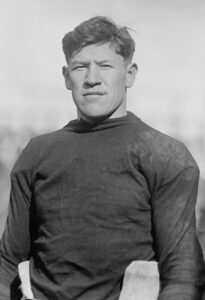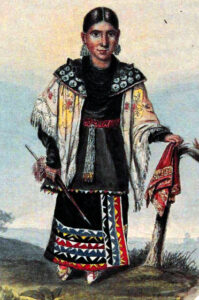Remembering a Significant Local Native American Figure
Writer / Jeff Kenney
Photography Provided
The month of March has been set aside as Women’s History Month, which provides a perfect opportunity to highlight the amazing story of a woman from the lakes region with a remarkable legacy, both in her own right and as the ancestor of a veritable household name in sports and history – but whose story is probably unfamiliar to the majority of readers.
One of the smaller lakes in the wider Lakes Magazine readership area is technically named Lake Bruce, though one nearby community is perhaps rather confusingly known as Bruce Lake. The 245-acre lake itself actually spans two counties: Pulaski and Fulton, though the majority of it sits in Fulton County.
Adding to potential historical confusion, just down the road from Lake Bruce is the little town of Kewanna, Indiana, with a population of around 600. That part, of course, is fairly straightforward, but it might be slightly confusing to note that the town of Kewanna was named for Potawatomi Chief Kee-Wau-Nay, whose village sat on the banks of today’s Lake Bruce, then known as Lake Kee-Wau-Nay.
So, Bruce Lake is not located directly on Lake Bruce, and Kewanna is not actually at the specific site of Chief Kee-Wau-Nay’s village.
At any rate (and getting to the subject of our story), Kee-Wau-Nay’s village was the home of Massaw (sometimes spelled Mas-Saw), who artist George Winter described in his 1830s journal as “a chieftess of the Potawatomi.”
Winter knew whereof he spoke. The British-born artist made his way to Indiana to paint the Potawatomi people in the mid-1830s, realizing that they were soon to be forced to leave the area for reservation lands out west.
The artist, who eventually set up a studio and residence in Logansport, painted a number of full-color pictures of both individual Potawatomi and detailed portrayals of their lifestyle and surroundings, up to the time of their forced removal, in the infamous 1838 Trail of Death, from Marshall County, Indiana, to Kansas.
Winter not only meticulously documented the area Potawatomi visually, but he also kept extensive journals of what he observed, large excerpts of which (alongside a number of his paintings) were published by the Indiana Historical Society Press in the book “Indians and a Changing Frontier: the Art of George Winter.”
A significant amount of content in that book is dedicated to Winter’s descriptions not only of the Kee-Wau-Nay village and some of its more typical goings-on (games, a funeral, and the like), but also his firsthand witness of the treaty council held at the village starting in July of 1837.
Despite the passionate arguments of Chief Nas-Wau-Kee, the Lake Maxinkuckee-based chief chosen by the regional Potawatomi to be their spokesperson against the federal government taking their land, the chiefs had little choice but to sign away their land. A number of Potawatomi left for Kansas that same year, with most of the rest forced away at gunpoint during the Trail of Death.
Winter’s journals also convey the notable personage of Massaw, whose prominent, two-story cabin (Winter described it as a “log mansion,” certainly of unusual size and quality in the area, among Potawatomi and settler alike) served as a rooming house for important visitors including Colonel Abel Pepper, one of the representatives of the government at the council.
Massaw was married to a French Canadian named Andrew Gosselin and the two had a daughter named Maurie, who was around 14 at the time of the council in 1837. Gosselin would go on to serve as an interpreter during the government’s removal of the remaining Potawatomi during the Trail of Death.
 The daughter of Potawatomi Chief Wassato, Massaw stood out in a number of ways. She was wealthy, as evidenced by her clothing. Winter described the silver brooches, which covered her cape and are visible in his paintings of her, as well as her notably large, highly visible earrings. “The appointment of her dress were expensive, including her moccasins,” Winter wrote.
The daughter of Potawatomi Chief Wassato, Massaw stood out in a number of ways. She was wealthy, as evidenced by her clothing. Winter described the silver brooches, which covered her cape and are visible in his paintings of her, as well as her notably large, highly visible earrings. “The appointment of her dress were expensive, including her moccasins,” Winter wrote.
Some of her wealth surely came from her proficiency as a gambler “of no ordinary ability,” according to Winter, who added that “she played euchre very well, and those who understand the game of ‘poker’ said that she was an adroit expert, often raking men of experience who attended her.”
Winter also reported that Massaw made a sizable amount of revenue from providing room and board, not only to the whites at the council including Winter and Pepper among others, but with her home as a sort of ongoing inn, one of the only places to stay of its size and convenience in the area.
According to Blake Norton, Citizen Potawatomi Nation Cultural Heritage Center curator, quoted on the Citizen Potawatomi Nation website at potawatomi.org, Massaw held the unusual distinction of the position of “headman” despite being a woman. Marshall County area readers had a chance to meet Norton last fall at the dedication of a new portion of the Marshall County Historical Society Museum in Plymouth focused on the area Potawatomi story.
Norton says on the website that Massaw’s high standing in her community at the time “may be why she was noted as a man on the first two treaties she signed…women did sign treaties, but this would come a couple of years later as more land was being sold and reserved.”
That standing some years after the 1838 Trail of Death is one of a few particularly notable facets of Massaw’s life and legacy.
Norton says that Massaw went on to become one of just five women to sign the treaty of 1861, which “divided the Kansas Pottawattamie Reservation between the two Potawatomi communities in Kansas. The treaty allowed one to continue living communally and provided the other, Massaw’s group, land allotments and a path to potential U.S. citizenship,” according to potawatomi.org.
Because of the influence of Massaw, that treaty also contained a clause giving the Potawatomi women equal rights with men, long before such laws were enacted at the U.S. government level.
Another enormously significant facet of Massaw’s legacy was one she did not live to see.
Another of her daughters, Elizabeth, married a man named Jacob Vieux, with whom she had three children, the family eventually moving to Oklahoma. One of those children, Massaw’s granddaughter, Charlotte, would marry Hiram Thorpe and give birth in 1887 to twin boys Charlie and James, better known as Jim. Norton notes that the boys had been enrolled on the Citizen Potawatomi rolls but were later placed on the Sac and Fox rolls.
Jim would undergo considerable suffering in his young life, losing his twin brother at age 9 and his mother, who died in childbirth, a few years later. Like many young Native Americans at the time, Jim Thorpe was forced away to a government-sponsored Indian school hundreds of miles from home, and there forbidden to speak his native tongue or practice his culture.
Thorpe thrived athletically and went on to international acclaim, winning the decathlon and pentathlon at the 1912 Olympics, and becoming a football and baseball star and the very first president of what would become the National Football League.
Besides his stature as the first Native American Olympic gold medal winner (at the games in Stockholm, Sweden’s King Gustaf V told him, “Sir, you are the greatest athlete in the world”) and a pioneer in breaking racial barriers in the athletic world, Thorpe was also named the greatest athlete of the first half of the 20th century by hundreds of American sports writers polled by the Associated Press in 1950 (Thorpe died three years later, in 1953).
While Thorpe is decidedly Massaw’s most famous descendant, Norton notes that many other of her descendants became successful in Oklahoma as “business people, farmers, athletes, decorated veterans and members of Tribal government, to name a small distinguished few.”
In 2020, a historical marker was placed in Massaw’s honor at PACA Park at Lake Bruce, the work of Winamac High School student and Eagle Scout Colton Benninghoff, the Citizen Potawatomi Nation, and the Fulton County Historical Society.
The last of more than 80 historical markers covering some 660 miles along the Trail of Death route through multiple states, Massaw’s marker serves as one witness to her extraordinary legacy.





